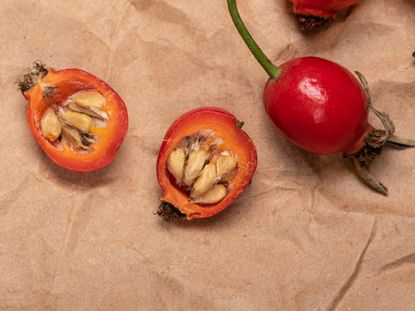Rose Bush Seeds - How To Grow Roses From Seeds


One way to grow roses is from the seeds they produce. Propagating roses from seed takes a little time but is easy to do. Let's take a look at what it takes to start growing roses from seed.
Starting Rose Seeds
Before growing roses from seed, the rose seeds need to go through a period of cold moist storage called “stratification” before they will sprout. Plant the rose bush seeds approximately ¼ inch (6 mm.) deep in a seed planting mix in seedling trays or your own planting trays. The trays need not be more than 3 to 4 inches (8-10 cm.) deep for this use.
When planting rose seeds from various rose bush hips, I use a separate tray for each different group of seeds and label the trays with that rose bush's name and planting date. The planting mix should be very moist but not soaking wet. Seal each tray or container in a plastic bag and place them in the refrigerator for 10 to 12 weeks.
Planting Roses from Seeds
The next step in how to grow roses from seed is to sprout the rose seeds. After having gone through their “stratification” time, take the containers out of the refrigerator and into a warm environment of around 70 degrees F. (21 C.). I do my best to time this for early spring when the seedlings would normally be coming out of their cold cycle (stratification) outside and starting to sprout.
Once in the proper warm environment, the rose bush seeds should start to sprout. The rose bush seeds will usually continue to sprout over the course of two to three weeks, but probably only 20 to 30 percent of the rose seeds planted will actually sprout. Once the rose seeds sprout, carefully transplant the rose seedlings into other pots. It is extremely important not to touch the roots during this process! A spoon may be used for this seedling transfer phase to help keep from touching the roots.
Feed the seedlings with half-strength fertilizer and be sure they have plenty of light once they start to grow. The use of a grow light system works very well for this phase of the rose propagation process. The use of a fungicide on the growing rose seeds will help keep fungal diseases from attacking the rose seedlings at this vulnerable time.
Do not overwater the rose seedlings; overwatering is a major killer of seedlings. Provide a lot of light as well as good air circulation to the rose seedlings to avoid disease and pests. If disease does set in on some of them, it is probably best to eliminate them and keep only the hardiest of the rose seedlings.
Gardening tips, videos, info and more delivered right to your inbox!
Sign up for the Gardening Know How newsletter today and receive a free download of our most popular eBook "How to Grow Delicious Tomatoes."
The time it takes for the new roses to actually flower can vary greatly so be patient with your new rose babies. Growing roses from seed can take some time, but you will be rewarded for your efforts.

Stan V. Griep contributed to Gardening Know How for many years. An American Rose Society Consulting Master Rosarian in the Rocky Mountain District, he served as Gardening Know How's in-house expert on all things roses.
-
 5 Night-Blooming Houseplants – Grow An Indoor Moon Garden
5 Night-Blooming Houseplants – Grow An Indoor Moon GardenThere is something uniquely special about night-blooming houseplants. Set the scene for a magical evening indoors with these fragrant flowering beauties.
By Amy Grant
-
 Beautiful Butterfly Garden Ideas: 10 Ways To Attract Pretty Pollinators To Your Yard
Beautiful Butterfly Garden Ideas: 10 Ways To Attract Pretty Pollinators To Your YardBringing butterflies to your backyard is one of the most important ways you can enhance wildlife, boost pollination and improve biodiversity. These 10 butterfly garden ideas can get you started
By Mary Ellen Ellis